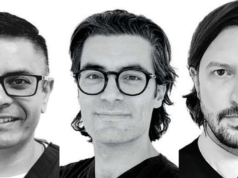
In an effort to raise the profile of paediatric interventional radiology (PIR), CVIR Endovascular Editor-in-Chief Jim Reekers (Amsterdam UMC, Amsterdam, The Netherlands) has invited Alex Barnacle (Great Ormond Street Hospital, London, UK) and Anne Marie Cahill (The Children’s Hospital of Philadelphia, Philadelphia, USA) to guest edit the journal’s first thematic series on the topic.
Barnacle and Cahill commissioned four review articles, which they say “detail the latest evidence for a range of complex interventions in children, demonstrating current best practices in this highly specialised field”.
Musing in an editorial about the lessons learned from these articles, Barnacle and Cahill write: “These reviews illustrate that many of the latest advances in adult IR are applicable in children, despite the concerns of many adult IR practitioners that such interventions may be too risky or perhaps futile. Each paper, however, also highlights the frustrations common to every paediatric interventional radiologist. These include the limited evidence base available to date, the lack of paediatric-sized equipment, and the challenges of developing and maintaining IR competencies with small caseloads, often focussed in only a few specialised centres.”
Whilst they acknowledge these challenges to PIR, they also note that the specialty has come a long way since the early 1980s, when the first paediatric papers were published in the interventional radiology space. According to Barnacle and Cahill, the first PIR workforce survey in 2007 identified “just 110 PIRs practising worldwide, rising to 177 in a follow-up survey 10 years later”. However, in 2020, more than 600 delegates from 22 countries registered for the Society for Pediatric Interventional Radiology (SPIR) annual congress. The editorialists suggest that this is “in part due to the advantages of new online conference accessibility during the COVID-19 pandemic”, but that this “groundswell of interest may be influenced by increasing visibility of the speciality through the work of publications such as this [CVIR Endovascular] and organisations such as SPIR, but we believe it also speaks to a growing interest in a speciality that brings great rewards for those searching for greater meaning in their work. There is immense satisfaction in giving a family real hope for their child and providing care that often means accompanying a child throughout their journey to adulthood.”
They conclude their editorial with a call to action: “It is imperative that we strive to eliminate the inequality that means the vast majority of children even in developed countries are denied modern, minimally-invasive, safe, and highly effective IR procedures that are routinely offered to adults. Significant progress has been made in recent years by a small, highly dedicated PIR workforce, but there is still much more to be done.”
Interventional News spoke with Barnacle about the publication of the CVIR Endovascular guest editorial, to gain insights into the urgency and nature of future PIR work.
 What is the significance of having the first CVIR Endovascular thematic series be dedicated to paediatric interventional radiology (PIR)?
What is the significance of having the first CVIR Endovascular thematic series be dedicated to paediatric interventional radiology (PIR)?
This is a real honour for our sub-specialty. This series highlights the breadth and depth of PIR. We hope it will give readers cause to stop and think, and consider what they could perhaps apply in their practice.
What have been the pivotal developments in PIR research and clinical practice since its inception in the early 1980s?
Over time, we have shown that there is far more that is possible in small children than even we could have imagined. PIR has changed the management of a number of diseases and provided minimally invasive options for thousands of children who would otherwise not have been offered treatment or would have undergone far more invasive surgery.
What areas of PIR do you feel are particularly under-researched/ demand greater attention?
It is a real challenge to trial interventional oncology (IO) treatments in children because almost all patients are on protocols that do not include IO options. PIR is where adult IR was 20 or 30 years ago, only being given access to patients who have failed most other interventions. This means that the data are sketchy and our patient cohorts are skewed. In time, we hope to see the oncology organisations show greater confidence in the aims we are pursuing.
What are the biggest challenges to PIR currently, and how can these be overcome?
The biggest hurdle outside of North America is getting hospitals to recognise what PIR can do when it is a fully resourced service. Most centres are not aware of what we can deliver or the benefits we bring. We need more training schemes, more consultant posts, and the commitment to building PIR in several centres in each country, so that children everywhere have access to minimally-invasive, effective IR treatment options.
What message do you want to give to those considering a career in PIR?
PIR is such a rewarding career! Contact a PIR centre near you and ask to visit—you will be amazed by what our departments offer and may be inspired to join us in growing this speciality together.
You can read the full PIR series on CVIR Endovascular here.
The full list of articles can be found below:
- Paediatric IR: the evidence for best practice is growing
- Vascular anomalies: special considerations in children
- Renovascular hypertension in children
- Managing systemic venous occlusions in children
- Endovascular approaches in pediatric interventional oncology













